Bonham, Texas -- You walk into the Credit Union of Texas, Don Toro or Studio 94 on the east side of the Bonham square, into Belle Rae’s on the north, into Blessing & Butterflies or The Curiosity Shop on Main south of the Courthouse: do you look down? What do you see when you cross the threshold into these businesses? Do you see Bonham’s past?
Because by looking down, by seeing the iron thresholds of over 140 years ago, you can catch a glimpse of the beginnings of the commerce in Bonham.
I’m not sure what sparked this adventure, this trip down a historical rabbit hole if you will, but I became intensely interested in learning about the people who left their marks. I wanted them to mean something again, if only for the length of an e-News article.
I cannot pinpoint the date the thresholds were put in place, but one clue is found in the barely visible second line of the Newman work on the north side. There is an ‘8’ where the century of the date should be. Given that the work was done by Sherman Iron Works, a foundry established in 1876 and destroyed by fire in 1904, the 1880s or 1890s is logical. Once, the thresholds circled the square and went north and south on Main Street.
For help with my resources, I turned to Malinda Allison, Fannin County Museum of History. Her guidance was invaluable.
Want to see a map of Bonham from 1885? The Perry-Castenada collection through the University of Texas has the Sanborn’s Fire Maps. Bonham’s range is 1885-1917. The Portal to Texas History compiled by The University of North Texas has links to 100-year-old newspapers such as the Bonham News and the Bonham Daily Favorite. Let me simply say, modern journalism can’t touch the florid writing. Fannin Pastperfect Online from the Fannin County Museum of History is equally valuable.
But let’s not get ahead of ourselves. Let’s start with one of Bonham’s more prominent citizens of the late 19th century, Voorheis Abram Ewing, or VA Ewing as styled on his threshold.
Ewing was born in Ohio and came to Bonham in 1873. Three years later he married Amy Caldwell, the sister of Cordelia Newman of the north side of the square. He opened a wagon shop and specialized in anything made of bois d’arc wood, especially the bois d’arc wagon wheel, his letterhead even proclaiming, “The Indestructible Bois d’arc Timber a Specialty.” He shipped these wheels all over the South. His shop on the east side of the square was constructed from the hand-made bricks salvaged from the 1881 courthouse being torn down to build the 1888 one. He even used the bricks in the construction of his home on the corner of Chestnut and 6th Streets.
Ewing’s business on the east side of the square was variously cited by the Sanborn maps or historical references as a ‘woodwork machine shop,’ ‘wagons and harness,’ ‘hardware and harness’ or ‘Ewing’s Saddle Shop.’ It starts as just a storefront but in the later maps consumes the entire block behind it. Sometime in the first decade of the 20th century it sold to a Taylor and a W P Owens. In 1902, Ewing was in partnership with AR Caldwell, in the City Steam Laundry.
People perhaps were no better at paying their bills in 1898 than they are today as noted in this Bonham News piece from October 28, 1898.
“Fair Warning: All parties indebted to me either by note or account are requested to come in and settle at once. Do not delay the matter. VA Ewing”
The Ewings were not only prominent in the business world of Bonham, but in the social and religious life. He was a charter member of the First Presbyterian Church and in a January 8, 1913, notice in the Bonham Daily Favorite he is listed as a trustee of the church whereby the church is being assessed for paving on Center Street, per the State.
VA Ewing’s death on April 8, 1916, shocked the community. I would encourage anyone interested in reading a most unusual (by 2025 standards) obituary to follow the links from the Willow Wild Cemetery site to read it.
As an incentive, the first sentence from the Bonham Daily Favorite, April 10, 1916, reads: “Last Saturday night, just two short hours before the great clock in the Temple of Justice tolled the hour of midnight, thus changing the day of labor into the day of rest, the Silent Messenger on a mission from the Great God of the Universe hovered over the city of Bonham.”
Of the three children born to the Ewings, only daughter Josephine survived. She married Henry L Nunn of Nunn-Bush Shoes and lived in Milwaukee. In 1939 Josephine gifted the church with a Communion Cloth in her mother’s honor.
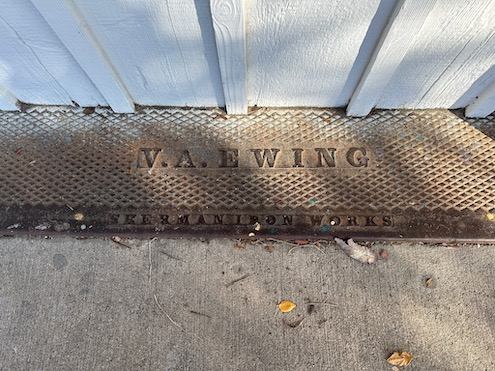

John H Ewing was born in Tennessee in 1850 and, as best I can tell from census records, was VA’s brother. Newspaper accounts of him are scarcer. In the 1880 census he gave his occupation as Carriage Painter. The 1885 Sanborn maps list JH Ewing’s Wagon Yard on the east side of the square next to VA’s. He served on the City Council for Ward 4. Although he died in Big Springs TX in 1895, he is buried, as is his brother, in Willow Wild. 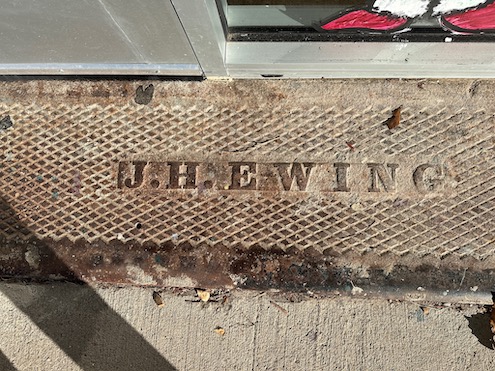
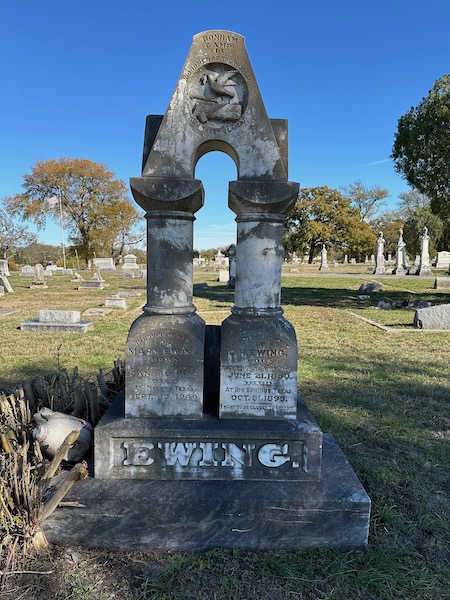
James Wesley Newman (1838-1912) was born in Knox County, TN. As a youth he had been apprenticed to a saddlemaker. Shortly after his marriage to Cordelia Caldwell in 1858, they set out in a covered wagon with her two brothers and five younger sisters to Texas. One sister, Amie, would marry VA Ewing. Newman joined the Confederacy but spent most of the War in saddle and harness workshops in Shreveport. Returning to Bonham, he opened a saddle shop on the north side of the square. By April 1886, he has a patent for a new riding saddle. In October 1904 he quit business and sold out at cost.
He was a Mason and treasurer of the Masonic Female Institute. He served on the City Council and was a charter member of the First Presbyterian Church.
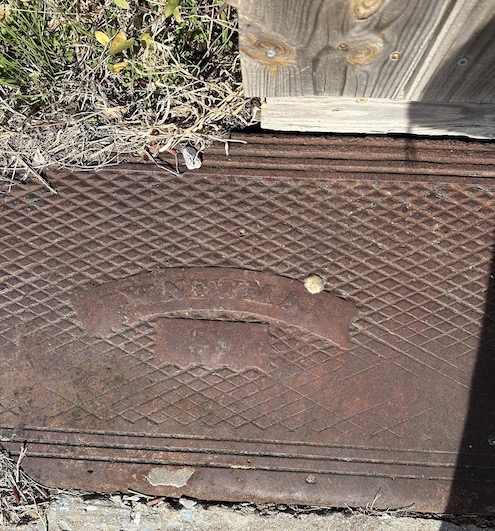
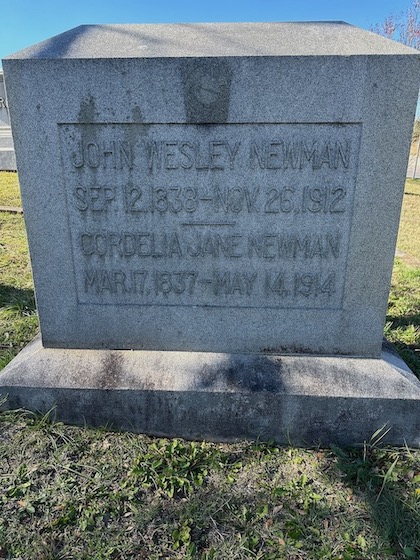
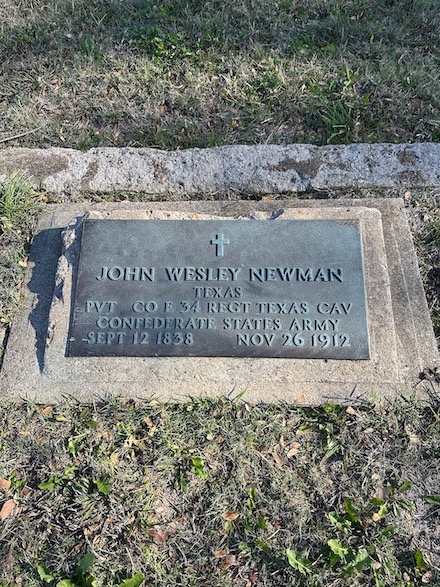
It was harder to pin down James Watson Dabney and next to impossible for B (probably Benjamin) Dabney, the other threshold on Main south of the Courthouse. Born in Memphis TN in 1832, Dabney spent many years in New Orleans before coming to Bonham and opening a hardware store specializing in farm implements. His ads in the papers declare he sells “eagle” cultivators, stalk cutters and steel lever harrows. According to his obituary he was much respected in the community. He died in 1910 after a lengthy illness and is buried at Willow Wild. If you look inside the shops which bear his thresholds, you can see scarred hardwood floors. Perhaps they harken to his business over 100 years ago.
As to B Dabney, there seems to be a generational gifting of that name. This was probably Dr. Benjamin Dabney. Was he a partner in the business? I don’t know.
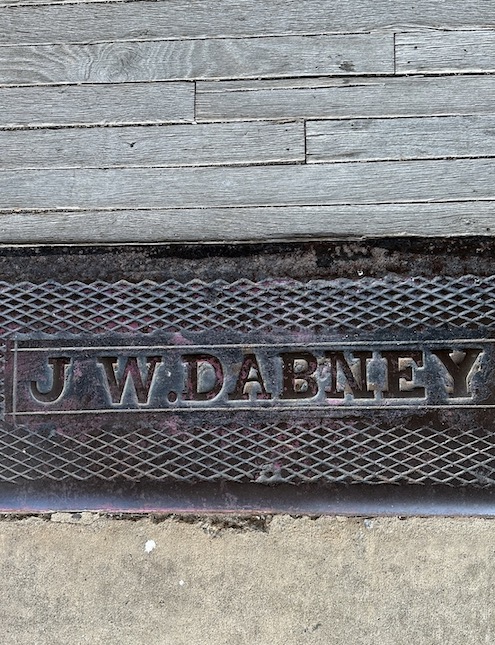
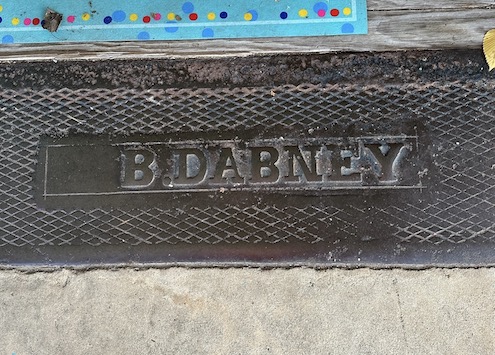
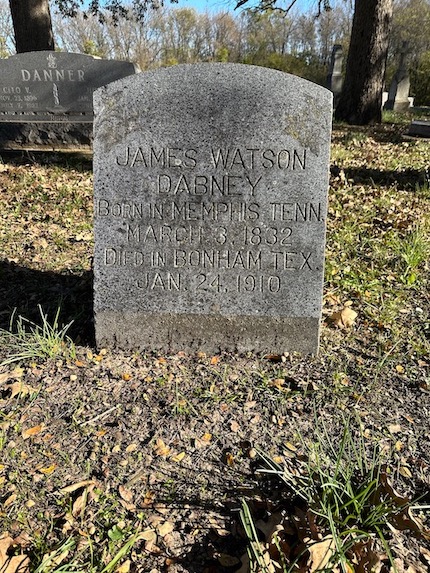
All these men and their families left a mark on Bonham. But what of the owner of the Sherman Iron Works? If not for his handiwork, we wouldn’t remember them at all.
Zadock Pratt Dederick was born in 1849 in Hensonville NY and died in 1923 in Sherman. He was a patent attorney, an inventor of a well borer, and the owner of Sherman Iron Works, established 1876. He was married three times, had nine children, and declared bankruptcy in 1900. This must not have deterred him from continuing in his business because a letterhead found on eBay declares ‘New Works 1901.’ By 1900 he is also advertising himself as a ‘US Patent Solicitor’ and in 1917 he announces a patent for AM Teague’s Telephone Directory, Business Guide and Calendar. The destruction by fire of the Iron Works in 1904 is heavily reported all over Texas, with losses estimated (depending upon the paper) from $12,000 to $44,000. In all cases, it was underinsured and was the property of Eastwood and Mankin.
Who else have we missed? Who else is hidden beneath storefronts which were brought out closer to the street sometime in the past and now cover the iron work?
Who else have we lost?
LINKS:
Portal to Texas History: texashistory.unt.edu
Perry-Castaneda Library: maps.lib.utexas.edu
Fannin County Collection: fannin.pastperfectonline.com
Cited: Fannin County Folks & Facts
Bonham The Era has gone—But Memories Linger On
Kay Layton Sisk is a romance author who obviously enjoyed researching this part of Bonham's history and boring everyone within earshot of the details of her progress!


